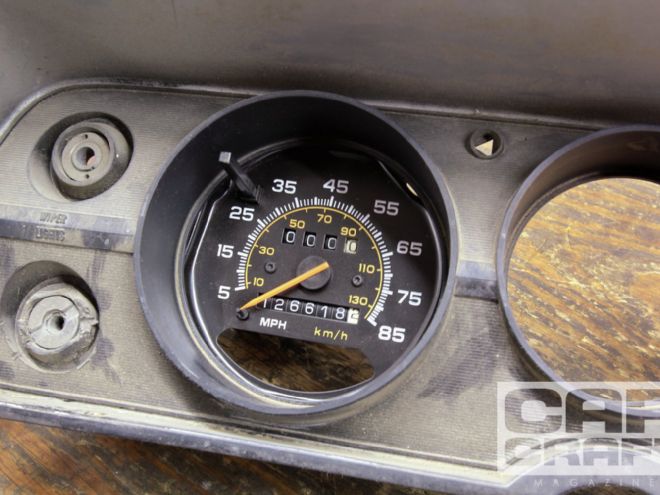
We don't have to tell you that late-model overdrive transmissions have become a prototypical upgrade for any kind of performance car. The number and variety of these transmissions makes that decision pretty easy. So let's say you've jumped into the deep end of the pool and stuffed a 4L80E automatic or a T-56 six-speed into your Chevelle, and at some point in the conversion, you realized that these gearboxes long ago flushed those clunky gear-driven mechanical speedometers. Every late-model transmission now transmits what is called a vehicle speed sensor (VSS) electrical pulse. Yes, there are aftermarket extension housings that convert to a mechanical drive if you want to go that route, but we were looking for something that integrates the smoothness and accuracy of a late-model electric speedometer.
There are several ways to go about this electric conversion. Let's start with the easiest route. Let's use the example of a first- or second-generation Camaro running a 4L60/70/75E or the 4L80/85E. These electronically controlled overdrives require a dedicated electronic transmission control unit. We previously tested five of these units (“In Control,” Mar. '12). If you are using one of these control boxes, all of them output a vehicle speed signal that will work with most aftermarket electronic speedometers. In the case of the CompuShift II box, the output is even adjustable.
Now let's assume you are using a factory manual overdrive like the T-56 six-speed. These transmissions typically output a signal from the VSS, which can be wired directly to an electronic aftermarket speedometer. The aftermarket speedos, such as those from Auto Meter or VDO, are designed to be calibrated by simply pushing a button on the speedo, driving a known distance (2 miles in the Auto Meter example), and punching the button again. This calibrates the speedo to your particular tire size and gear ratio, making the setup ridiculously easy.
The only time you might need a calibration box would be if you were trying to calibrate a late-model transmission to a factory electronic speedometer. Classic Instruments sells a simple-to-use box, as does Dakota Digital and Auto Meter. As an example, connect the VSS output to the Classic Instruments unit and then wire it to the speedometer. Hit the button on the interface, drive the car an exact measured mile, and hit the button again. This calibrates the VSS signal into the speedometer from the VSS output, and the speedometer will be accurate. This box, the SN-74, is an upgraded version of Classic Instruments' original box that eliminates flipping dipswitches. This conversion box would only be required when working with a factory-style speedometer.
Another route will eliminate connections to the transmission altogether via a GPS speedometer signal. Auto Meter, Classic Instruments, and others sell a GPS box with an antenna that triangulates from a minimum of three geo-synchronized satellites to establish very accurate speed and distance information that is fed to the speedometer. These units will work with virtually all aftermarket electronic speedometers. The only downside to these that we see is they sometimes require a minute or so to establish satellite contact and can lose signal in long tunnels.
So then the issue comes down to finding an electric speedometer. The simplest approach is using an aftermarket unit from companies such as Classic Industries, Auto Meter, Speedhut, or Stewart-Warner. On the budget side, Auto Meter makes an inexpensive 120-mph electronic aftermarket speedometer in a 31⁄8-inch diameter that sells for only $135 from Summit Racing. We also found a Speedway Motors 120-mph speedo for $69. Budget speedometers generally need an interface box to calibrate the signal between it and the VSS sender. The Auto Meter unit might be a better deal because it does not need an interface.
Car Craft family member Tim Moore pulled an 85-mph electronic speedo out of a '90s Chevy van for $20 that could be a budget alternative. The problem is finding a factory speedometer that will fit your dash and still looks like it belongs. That will probably not be easy. We spoke with Shannon Hudson at Redline Gauge Works, who told us you should be able to use a Dakota Digital or Classic Instruments interface box to adapt the signal from the transmission to the specific requirements of a factory digital dash, but he was not willing to say that these boxes would be compatible in all situations.
As a more useful alternative, Hudson told us that he regularly converts older mechanical speedos to electronic, and if that's all you want done, it can cost as little as $300–$350. This conversion will also create a digital odometer reading, so the revamped speedo won't be exactly stock. Shannon says that most of his customers actually prefer the digital odometer.
So there you have it, a quick rundown of some of the electric speedo options for an aftermarket overdrive transmission in an older car. There really isn't a stupid-cheap $29.95 option but neither is converting to an overdrive automatic or manual transmission. Of course, if you've ever lived with an ancient, needle-bouncing, cable-driven speedometer, you already know that these should be more accurately called a speed suggestion gauge. And that's after you've spent hours calibrating it with handfuls of plastic gears. We've been there, and that just makes an electric speedometer much more attractive for a host of low-stress reasons.
Parts List
Description PN Source Price Classic Sky Drive SN-81 Summit Racing $250.00 Classic Interface SN-74 Summit Racing 111.00 Classic Camaro Speedo CAM67GS Summit Racing 1,100.00 Auto Meter GPS interface 5289 Summit Racing 207.97 Auto Meter speedo 1487 Summit Racing 134.97 Auto Meter speedo 1489 Summit Racing 249.97 Auto Meter 3-wire sensor, GM 5291 Summit Racing 82.97 Auto Meter 3-wire sensor, Ford 5292 Summit Racing 88.97 Dakota Digital conversion box SGI-5-C Dakota Digital 84.95 Speedway speedo 91065051 Speedway Motors 69.99
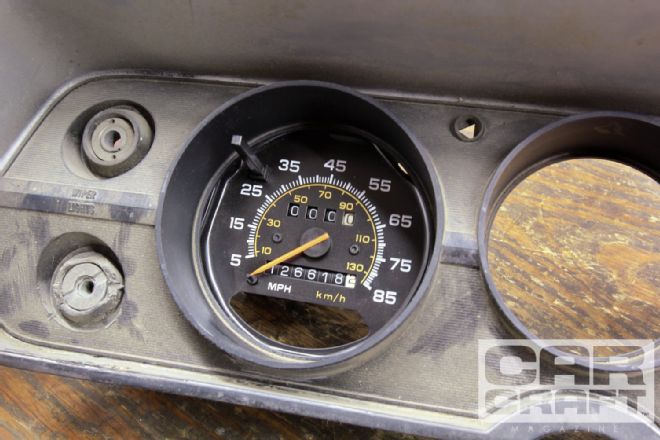 If you are really trying to keep cost down, consider looking for a suitable electronic speedometer in the boneyard. Tim Moore found this decent-looking 85-mph speedo. The hassle is supplying the speedometer with a proper calibration signal. The connections on the back of the speedo include 12-volt switched power, ground, and the signal input. We test-fitted this in a ’65 Chevelle instrument bezel, and it fit quite nicely. The problem is finding an accurate, matching tach.
If you are really trying to keep cost down, consider looking for a suitable electronic speedometer in the boneyard. Tim Moore found this decent-looking 85-mph speedo. The hassle is supplying the speedometer with a proper calibration signal. The connections on the back of the speedo include 12-volt switched power, ground, and the signal input. We test-fitted this in a ’65 Chevelle instrument bezel, and it fit quite nicely. The problem is finding an accurate, matching tach.
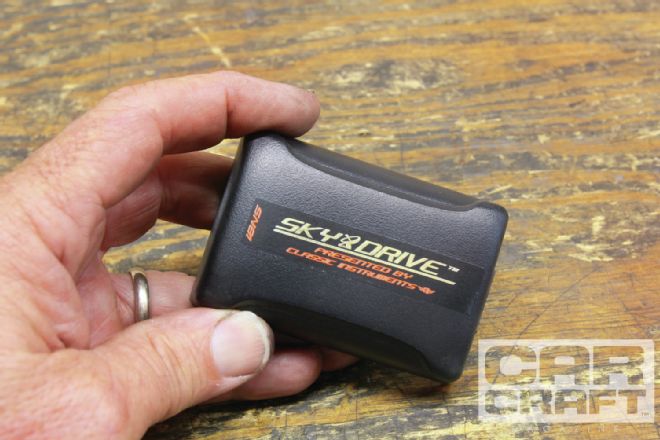 The Sky Drive from Classic Instruments makes calibrating an electric speedometer the easiest thing in the world. Merely mount the antenna where the unit can reference GPS satellites, hide the box anywhere, and power it up. No calibration is necessary. The update rate is fast enough that 1 mph accuracy is attainable. The Sky Drive is designed to work with most aftermarket speedometers.
The Sky Drive from Classic Instruments makes calibrating an electric speedometer the easiest thing in the world. Merely mount the antenna where the unit can reference GPS satellites, hide the box anywhere, and power it up. No calibration is necessary. The update rate is fast enough that 1 mph accuracy is attainable. The Sky Drive is designed to work with most aftermarket speedometers.
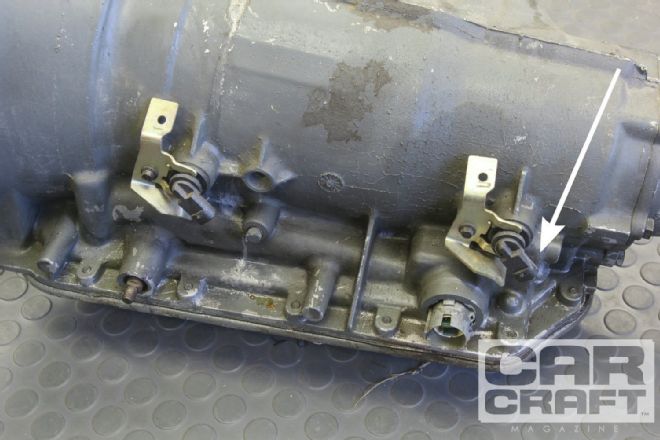 On this 4L80E automatic, the rear vehicle speed sensor (VSS, arrow), located toward the back of the transmission is called the TOSS, or transmission output speed sensor. Most two-wire VSS units generate an AC voltage signal that is more like a sine wave as opposed to three-wire (DC) voltage signal generators. To test a two-wire VSS, hook the sensor wire to + and the other wire to ground on a multi-meter, and drive the car while observing the output on the AC scale. The output voltage should increase with speed.
On this 4L80E automatic, the rear vehicle speed sensor (VSS, arrow), located toward the back of the transmission is called the TOSS, or transmission output speed sensor. Most two-wire VSS units generate an AC voltage signal that is more like a sine wave as opposed to three-wire (DC) voltage signal generators. To test a two-wire VSS, hook the sensor wire to + and the other wire to ground on a multi-meter, and drive the car while observing the output on the AC scale. The output voltage should increase with speed.
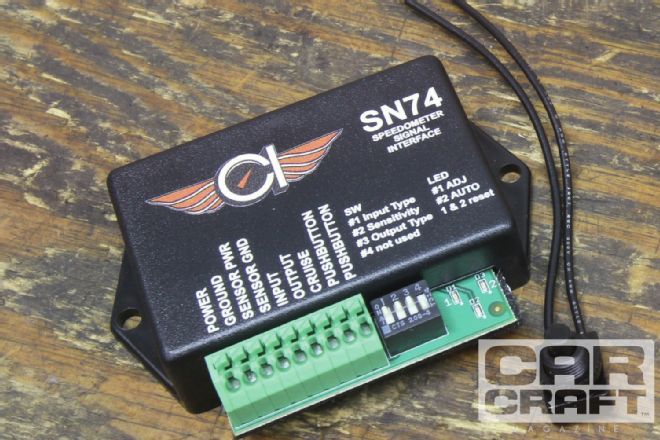 Some aftermarket electric speedometers require an electronic interface box like this SN-74 from Classic Instruments that converts the VSS signal to a specific count recognized by the speedometer. All you do is wire the box, hit one button, drive a measured mile, and hit the button again. The interface calculates the offset necessary to make your speedometer accurate. It’s that simple.
Some aftermarket electric speedometers require an electronic interface box like this SN-74 from Classic Instruments that converts the VSS signal to a specific count recognized by the speedometer. All you do is wire the box, hit one button, drive a measured mile, and hit the button again. The interface calculates the offset necessary to make your speedometer accurate. It’s that simple.
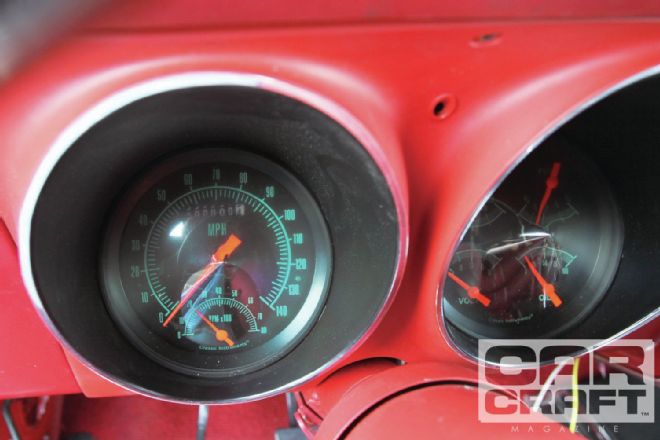 The beauty of electronic speedometers is that you can get very creative with the layout. This is a Classic Instruments G/Stock series with the speedometer/tach on the left and volts, water temperature, oil pressure, and gas gauge on the right. This kit is designed for a ’67–’68 Camaro and bolts directly in place of the stock instrument panel.
The beauty of electronic speedometers is that you can get very creative with the layout. This is a Classic Instruments G/Stock series with the speedometer/tach on the left and volts, water temperature, oil pressure, and gas gauge on the right. This kit is designed for a ’67–’68 Camaro and bolts directly in place of the stock instrument panel.
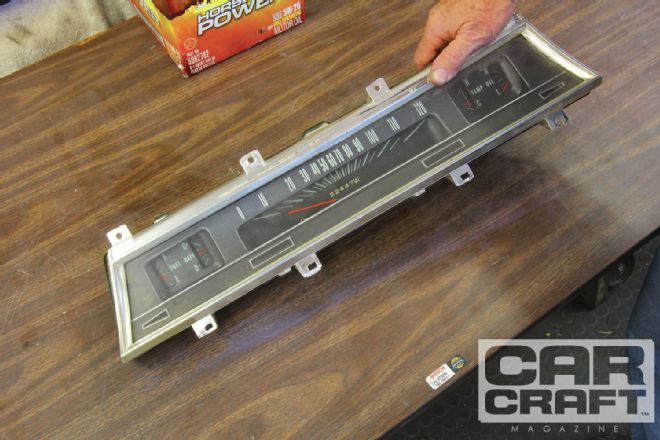 Redline Gauge Works can convert an old cable-driven speedometer to a fully electric version and retain the stock external appearance. The best part is that the starting price is around $350. As an example, Redline can convert this ’66 Chevelle 120-mph speedometer to 160 mph for a reasonable price that would still look stock using Auto Meter internals.
Redline Gauge Works can convert an old cable-driven speedometer to a fully electric version and retain the stock external appearance. The best part is that the starting price is around $350. As an example, Redline can convert this ’66 Chevelle 120-mph speedometer to 160 mph for a reasonable price that would still look stock using Auto Meter internals.
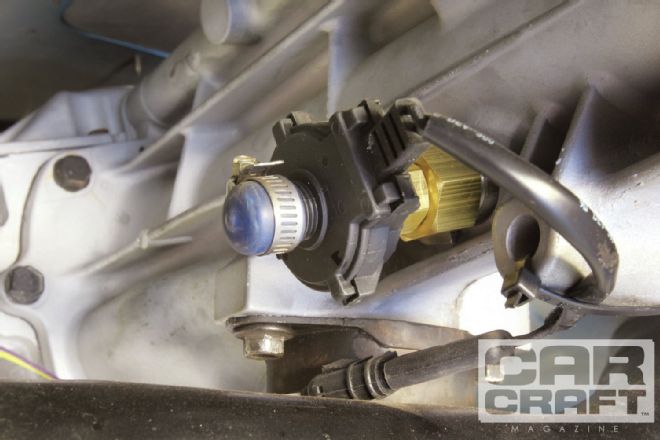 If you want to convert to an electronic speedometer, but the transmission output is still a cable, you can use a cable-driven DC generator such as this Auto Meter unit that will produce a square wave signal that can be converted to an electronic signal. End
If you want to convert to an electronic speedometer, but the transmission output is still a cable, you can use a cable-driven DC generator such as this Auto Meter unit that will produce a square wave signal that can be converted to an electronic signal. End